Polaris founders Edgar Hetteen and David Johnson led a group across Alaska, retracing the path he used 40 years earlier to prove the concept of the snowmobile. Wayne Davis, an International Snowmobile Hall Of Fame honoree for his photography skills was invited on the trip to document the adventure.
Imagine being granted that one wish to spend some time with people you have admired your whole life or a hero that you have looked up to from afar.
A car buff may choose a cross-country automobile trip with Henry Ford. A complete space cadet may opt to strap into a rocket and revisit the lunar surface with Neil Armstrong. Both of these men changed the world with their innovation and exploration to go where no other man has traveled before. In the end, history was recorded and the world was changed because these heroes went against all odds to break new trails.
Growing up in Minnesota, I, too, have some heroes who used their inventive skills to create the snowmobile in the same year I was born. For me, that person is Edgar Hetteen, founder of Polaris Industries and Arctic Enterprises. In March 2000, I was a part of a 10-member crew that retraced Hetteen’s historic 1960 snowmobile trip across Alaska.
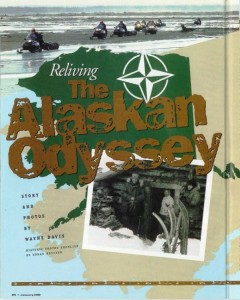
And leading the group was Hetteen himself.
Snowmobiles have been a huge part of my life, and some of my heroes unknowingly helped forge my life with their inventions and their deeds many years ago.
I can recall working in my Uncle Marvin’s dealership as a kid. A poster of Allen Hetteen in a suit and coat next to a 1962 Polaris SnoTraveler hung above the sink. The poster’s text told of a man named Edgar Hetteen who rode across Alaska on a Sno-Traveler – just like the one on the poster – to prove the snowmobile’s capabilities and dependability as winter transportation.
Every time I washed my hands at that sink, I marveled at the magnitude of that feat. “Imagine,” I’d think, “traveling all the way across the gigantic wilderness of Alaska on a snowmobile!” I’d imagine what fantastic sights I’d see, and think about the dangers and perils I’d face attempting to navigate 1,200 miles where no machine had gone before!
What a great adventure, and it finally became my own.
Prelude To A Dream
In the fall of 1999, a good friend that works at Polaris named Ed Skomoroh laid out plans for a re-creation of Hetteen’s Alaska trip. Bob Persson, a friend of Hetteen’s, suggested another Alaskan adventure to mark the 40th anniversary of the journey. Hetteen himself was going on the trip as well as Polaris co-founder David Johnson, Polaris CEO Tom Tiller and a variety of other people from Polaris, Skomoroh said. The idea was to cover the same route taken by the crew on the 1960 expedition.
Hetteen wanted to include stops in the same villages to see if any landmarks from the first trip still existed. Then Skomoroh said the words that I will never forget:
“We were wondering if you would consider going on the trip with us to photograph and document the trip.” I couldn’t believe what I was hearing. Skomoroh said I could take a few days to consider it and get back to him with the answer.
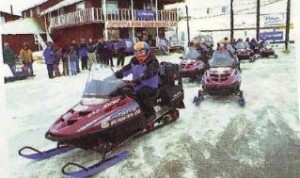
The answer came as one of the fastest decisions I have made in my life.
“Count me in,” I said immediately.
The list of people on the trip was capped at 10 and included Hetteen, age 79; Johnson, age 77; Tiller; Johnson’s son and Polaris’ ATV General Manager Mitchell Johnson; Persson; Polaris’ Vice President of Marketing Ed Skomoroh; Polaris Snowmobile Product Manager Bow Crosby; Polaris’ Vice President of Engineering Chuck Baxter; Hetteen’s son-in-law Jeff Miels; and myself. They contacted native Alaskan and Polaris cross-country snowmobile racer Earl Esmailka as a guide. Each person on the trip received certain assignments. My responsibilities included shooting as many photos as I could to document the trip. My second job was to videotape the trip for a documentary video Polaris hoped to make. The final task seemed the most exciting: to take digital photographs and send them back over a high-tech satellite phone system directly to a website. Polaris created a site where curious people could follow the trip.
To make all this high-technology equipment work on this trip required hours of research. Equipment testing went right up to minutes before we were to leave our starting point of Bethel, Alaska. We had to make sure that even though we rode into remote regions of Alaska, we could depend on our equipment. After we loaded the equipment into the tow sleds, we wondered if it would survive the extreme conditions that we were about to encounter.
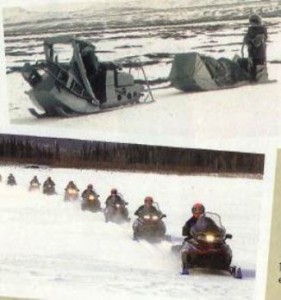
We all rode on fan-cooled 2000 Indy Sport Tourings for the trip. Because we didn’t know what kind of snow conditions we’d find, we knew the 550 fan-cooled engines would handle the task. Moreover, the trip was in part a fundraiser for ALS, or Lou Gehrig’s disease. This charity was chosen in honor of Polaris engineer Wes Blakeslee, who has ALS. Coincidently, Blakeslee spent a good deal of time engineering the Sport Touring.
As we pulled away from that Polaris dealership in Bethel, I was ecstatic. I was finally in the saddle with the purr of the engine whisking me over the snow.
“Relax,” I kept telling myself . “Look around; your dream is coming true.”
Later that day, we got our first taste of what it was like to stop in the villages and visit with school kids. They were so excited to see us. They listened intently to the stories of why Hetteen made this trip in 1960 and why he’s doing it again now. Johnson told how he built the very first snowmobile because he was too lazy to walk through the snow to his hunting spots. Hetteen came back from vacation to discover Johnson’s invention. Johnson’s story was met with laughs and amazement at how this whole iron-dog machine was born.
At the end of the speeches, the kids asked questions of the group. “Why are you all wearing helmets?” one student asked. “Why did you pick that particular snowmobile to make this trip?” said another. “We like your whiskers,” one small child blurted out, causing the whole room to burst into laughter.
The older people in attendance directed their comments to the engineering minds of Crosby and Baxter with improvement ideas or a particular engine that they would like to see in a particular chassis. After we talked with the kids, they asked us to autograph the mini posters we gave them. We spent a lot more time than we had planned signing our names for those kids. We didn’t mind, though, and enjoyed it very much.
This scenario, with the students, the stories and the autographs, was revisited nearly every day.
Past And Present
The first day on the trail went so well that we left the village of Tuluksak the next morning excited for the adventure to continue.
The second day was going to be a long ride of about 160 miles with a stop at the home of Alex Aloysius in the village of Kalskag. Aloysius guided Hetteen and the original crew safely across the great portage on the 1960 expedition and played an instrumental part in the success of that early trip.
I could sense the anticipation in Hetteen as he walked into the house to meet Aloysius again 40 years later. It didn’t take the two old friends very long to get reacquainted, as they looked over Hetteen’s photographs. They shared memories of that special adventure they undertook so long ago.
Hetteen remembered that he and the crew were going to try to navigate the portage with compasses and maps. Aloysius laughed loudly and said, “If you would have tried to use a compass to get you through, you would still be wandering around out in those trees!”
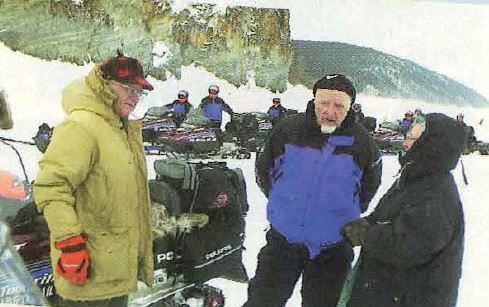
With the best wishes for a good trip from Aloysius, we left to cross the portage. The wonderful sunny day showed off some of the best scenery that Alaska has to offer. As we stopped for gas in the town of Holy Cross, Hetteen made a keen observation.
“Take a look around,” he started. “I’m so amazed at seeing so many snowmachines, almost every house. Every village we went through has a snowmobile of some kind sitting by the house. And look at how people of all ages are using them for every aspect of their lives.”
On his first trip to Alaska, he saw dozens of dog sled teams, and of course no other snowmobiles. Up until this point on the 2000 trip, though, we had seen only one dog sled team on the trail. We did, however, see thousands of Alaskans using snowmobiles exclusively for their transportation. I considered the men who dared to do something different, built a snowmachine and took it on a trip so long ago – and how it drastically changed the way so many people live, even in the wilds of Alaska.
Homecoming
Because of the late arrival into Grayling the night before, day three began with a visit to the school. We were impressed to see the school decorated with “Welcome back to Grayling” signs and a ’60s vintage Sno-Traveler in front of the school.
Kaltag was the next destination village for the group. Our guide, Esmailka, had even more reason to hope the riding would go well. Kaltag was his home village, and while he was on the Breaking Trail 2000 trip his wife, Marion, gave birth to a baby girl, their third child. Esmailka was anxious to see his new daughter, as well as the rest of his family, and pressed on at a good pace.
As we got closer to the village suddenly the going got slower, as some of us in the group tried to make it all the way without topping off our gas. One by one, our tanks ran dry. This forced the group to turn around, bring the gas to whomever was empty. We all felt so bad for Esmailka that at times we were in sight of his village with his family waiting for him to arrive, and he had to keep stopping to help everyone get refueled and going again. Eventually we all managed to get regrouped and the sight of us arriving with Esmailka guiding us was a touching scene. We could see the pride in the faces of the villagers that one of their own was a part of this historic trip.
The next morning Mitchell Johnson presented the principal of the school in Kaltag, Conrad Detering, some special gifts. Included were letters from the school kids of Polaris’ hometown of Roseau, Minnesota, to the kids of Kaltag hoping to build some pen-pal relationships between the children of the two villages.
We left Kaltag in heavy whiteout conditions and we all had to stay close together to be sure no one got separated. As the day went on, conditions improved and we arrived in Galena in the afternoon. After Tiller, Hetteen and David Johnson participated in an hourlong live Internet chat, the group was treated to a gourmet dinner at the school. It was a fantastic surprise that was enjoyed very much by the entire group.
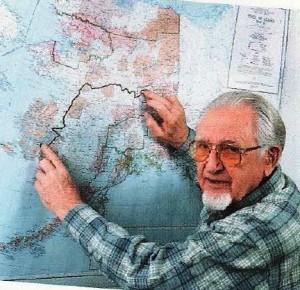
The following morning before heading out, we were treated to a couple of more surprises. The first was meeting a man that helped Hetteen get the Sno-Travelers ready for the rest of the trip after the 1960 expedition arrived into Galena. We then went to the home of author Sydney Harrington, who writes adventure books about Alaska.
The destination for day five was Ruby. Since the day’s ride was short, we spent some extra time shooting photos and video footage. Support pilot Bruce Friend took me into the air for some aerial photos as they traveled up the Yukon toward Ruby.
The view of Alaska from the plane was spectacular! It made me appreciate what a monumental feat the trek across this vastness was 40 years ago, as well as today. These thoughts were always on my mind as we traveled along the many rivers.
Often, I looked ahead of my sled and had this incredible rush come over me as I realized, “Holy cow, that’s Edgar Hetteen or David Johnson riding right there in front of me, and we are traveling on the very same trails that Edgar dared to conquer so many years ago, on machines that were first made by the hands of David Johnson in those early days!”
I felt blessed to be on this trip with these heroes of mine, and it was overwhelming at times. The friendships that were being forged among us that were on the Breaking Trails 2000 trip were growing stronger with each passing mile. I think each one of us could feel the tremendous history that surrounded us as we traveled together. With each landmark or cabin that we stopped at, we couldn’t help but feel enveloped in history as Hetteen recounted his early experiences. We looked at his black and white photos and listened to the stories. It was like the rest of the world didn’t exist; that it was all right here in this moment.
The historical feeling got even stronger with our arrival into Ruby. Rudy and Bessie Billberg, who accompanied Hetteen on the original trip, flew in to watch the team arrive in the village. What a surprise for us all, but especially nice for Hetteen as the trio found some time that evening to sit down and chat about their adventures that forged their bond of friendship – just as was happening with our group on this trip.
Beating Technology
That evening in Ruby, the technology connection failed us.
Miels and I tried, as we did each night, to send photos back via the satellite phone to the Internet. Just to the south of us was a large bluff that prevented a clear angle to the satellite. There was no way we would get a clear connection from town.
We loaded up the equipment and drove a few miles on our snowmobiles to the top of the mountain where we hoped for a better connection.
That night was extremely windy and cold. It took both of our best efforts to keep everything from blowing away or freezing up while trying to maintain a solid connection long enough to get the images sent. It took a few tries to finally get everything online, but thanks to his willingness to help out. We managed to get all the photos sent so everyone could enjoy them the following day.
Triumphant Return
The final legs of the journey went by so fast, as we had our final destination of Fairbanks drawing closer. A sense of sadness started to come over me as I realized this dream trip started to come to a close.
The trip was going so well and we still had several more villages and sights to see. I started to feel the success of the trip was at hand, that what we had set out to do was done and done well.
Our goal of raising awareness of Lou Gehrig’s disease in Alaska, as well as raising money to help with research, was going very well. Our talks to the kids about snowmobile and helmet safety was also well received, and launching of Polaris’ new campaign slogan “The Way Out” couldn’t help but be on everyone’s mind the entire trip.
Tiller commented that this trip exemplifies “The Way Out” in every way: being out in the fresh snow in the wilds of Alaska with machines that let us experience it firsthand is a really great thing that everyone should have the opportunity to experience.
The early morning frost clung to our machines the morning that we arose to pack our machines for the final time. We were on the last leg of our trip into Fairbanks.
Once we were under way it soon became obvious that we were in for an extraordinary day.
The temperature was cold enough to suspend ice crystals in the air. As the sun rose over the pine trees and mountains, it caught the crystals in the air and on the snow. It appeared as if millions of diamonds surrounded us as we drove along. Off to the side of the trail, groups of people waited for us and then joined in as we made our way toward Fairbanks.
Just a few miles from the end, a crowd of people waited for our arrival. Someone had brought a 1960 Sno-Traveler like the one Hetteen had driven into Fairbanks to a hero’s welcome 40 years ago.
Hetteen dismounted the snowmobile that had just carried him hundreds of miles and jumped onto the Sno-Traveler to finish the last few miles in the same fashion he had on the earlier trip.
What a grand way to finish such a great journey to see the team on their shining new snomwobiles coming into town single file behind the clanking, vibrating machine of old being driven by the man who dared to break trail into a new way of life for many, many people in the world.
Editor’s Note: Every issue of Snow Goer magazine includes in-depth sled reports and comparisons, aftermarket gear and accessories reviews, riding destination articles, do-it-yourself repair information, snowmobile technology and more! Subscribe to Snow Goer now to receive issues delivered to your door 7 times per year for a low cost.

I know this is an old post but is there a book available about this. It appears like it in the one photo but a search revealed nothing. Thank you!!